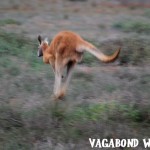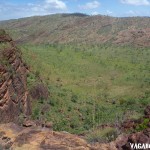Aboriginal Art, Petroglyphs in Australia
Both a country and a continent. I always envisioned Australia having massive tracks of land coated in red dust and rocks housing ancient carvings. There was something about finding and viewing Aboriginal Art that was so exciting to me. I imagined bare feet walking hundreds of kilometers into the bush thousands of years ago chipping away at rocks to create the images I saw. Aboriginal art has always held such powerful imagery in my head with its varying forms. I love the paintings that have thousands of small dots to the faces with intriguingly haunting expressions, impressionistic or realistic – there seemed to be such a mystery and energy to it – and something I wanted to learn more about.
I found understanding Aboriginal culture and art to be more difficult than I imagined. Even after living in Australia for over a year and a half, I left with so many unanswered questions. Their culture believes in the Dreamtime, which is a beginning that never ended and lays the ground work for the customs of their culture. With that said, there’s varying sources and statistics, but across the continent there was at one point about 250 languages with 600 local dialects spoken. There are aspects of the Dreamtime that are similar across tribes and there are aspects that are different for each tribe. Currently it is believed there are around fifty languages still spoken; however there are only twenty or so languages that have more than a thousand people speaking them that will survive into the future. The Aboriginal language was both spoken and presented through pictures, passed down by the elders. With the elders passing, many of the languages and dialects are going with them. There is currently an effort to transcribe the different dialects of the languages so they are not lost forever.
On the West Coast, near Karratha, we got to delicately wander through these massive fields of rocks viewing Aboriginal art. There is some contention to this particular site as to its conservation status and preservation. There are estimates that there are thousands of undocumented carvings here and without protection there is nothing to hold back the bulldozers. Much of this art is already in jeopardy of losing the ability to interpret the meaning as the languages are lost; it would be an even bigger shame to lose the art completely to development.
Here are some carvings from Burrup Peninsula, located approx 1500 kilometers or 932 miles north of Perth.












 Previous Post
Previous Post Next Post
Next Post
Neat piece of descriptive writing.
Love your photo art. Amazing!
Thank you! It is quite amazing how well preserved a lot of the carvings are.
It is a shame that this land is not protected from new development coming in and building on top of this. Hopefully it will remain a place to see Aboriginal art.
Hopefully, and also the land around will remain undisturbed, I think what is around historic sites is also important on what a viewer is able to experience and take away from a site.
Another FANTASTIC post!!! I learn something new in every one. This time the difference between petroglyphs and petrographs…
Thanks, always a good trivia question, the difference between petroglyphs and petrographs, in my head I try to remember by thinking that graphs have a line that has to be drawn, so I can remember petrographs are the paintings.